Water Pollution in the Meandering River, Ansys Fluent CFD Simulation Training
$160.00 $80.00 Student Discount
- The problem numerically simulates Water Pollution in the Meandering River using ANSYS Fluent software.
- We design the 3-D model by the Design Modeler software.
- We Mesh the model by ANSYS Meshing software, and the element number equals 762433.
- We use the VOF Multi-Phase Model to define water and air.
- We use the Open Channel option to define the free surface flow.
Click on Add To Cart and obtain the Geometry file, Mesh file, and a Comprehensive ANSYS Fluent Training Video.
To Order Your Project or benefit from a CFD consultation, contact our experts via email (info@mr-cfd.com), online support tab, or WhatsApp at +44 7443 197273.
There are some Free Products to check our service quality.
If you want the training video in another language instead of English, ask it via info@mr-cfd.com after you buy the product.
Description
Description
The present problem simulates the pollution of the meandering river using ANSYS Fluent software. We perform this CFD project and investigate it by CFD analysis.
Water pollution is the contamination of water bodies, usually due to human activities, in such a manner that negatively affects its legitimate uses.
Pollution prevents the body of water from providing the ecosystem services it would otherwise provide. Water pollution can be classified as surface water pollution or groundwater pollution.
The present model is designed in three dimensions using the Design Modeler software. The river’s width at the inlet is 14.035 m, and the pollutant inlet has two circular profiles with a diameter of 3 m.
The meshing of the model was done using ANSYS Meshing software. The element number is equal to 762433. Also, due to the nature of the present problem, the transient solver has been enabled.
River Methodology
This project uses the VOF multi-phase model to simulate and solve the two-phase flow field equations. Furthermore, to simulate the free surface of the river, the open channel option within the multi-phase module has been enabled.
Pollutant enters the river from two circular inlet profiles somewhere at the beginning of the river, and it diffuses into the water. Due to its density being lower than water density, pollutants cause the river’s surface to be polluted, and because of the water flow, pollution moves along the river.
The K-epsilon Realizable viscous model with scalable wall function has been used to solve the turbulent flow equations. The pressure-velocity coupling scheme is SIMPLE. The second-order upwind discretization method has been used for Momentum, and the first-order upwind discretization method has been used for Turbulent kinetic energy and Turbulent dissipation rate.
Moreover, the water enters the domain through the inlet boundary with 35m/s while the pollutant enters the river with 5m/s.
River Conclusion
After the solution process is completed, contours of velocity, pressure, pollutant volume fraction, Water volume fraction, Eddy viscosity, and streamline are extracted and presented in different time steps.
As can be seen, the pollutant enters the river from two circular inlet profiles and diffuses through time into the river’s surface. Due to the water flow, pollution spreads through the river’s surface and causes massive river pollution.
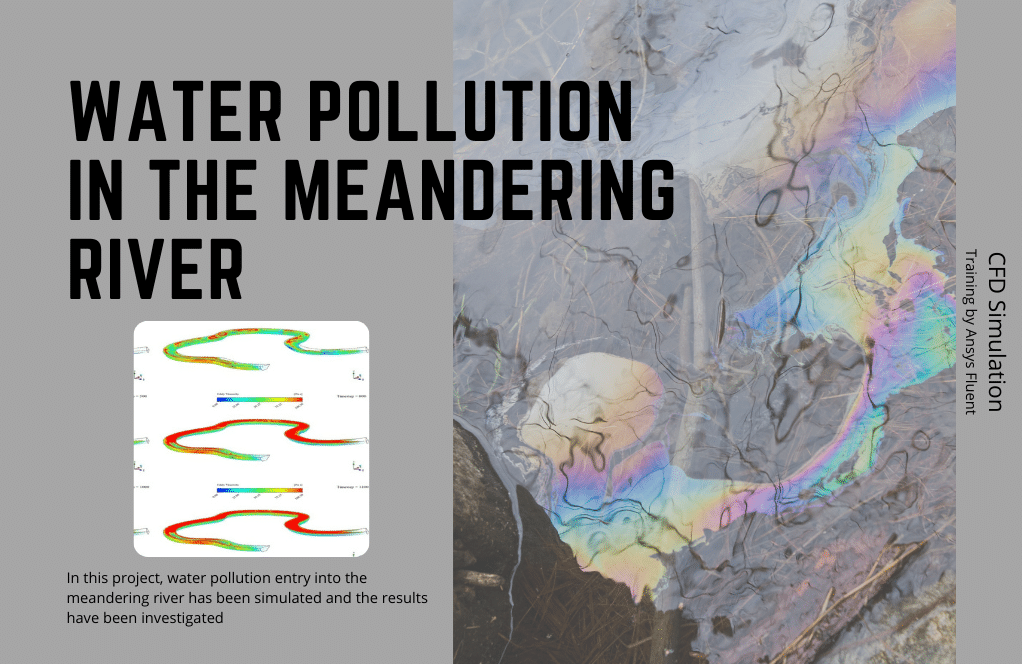
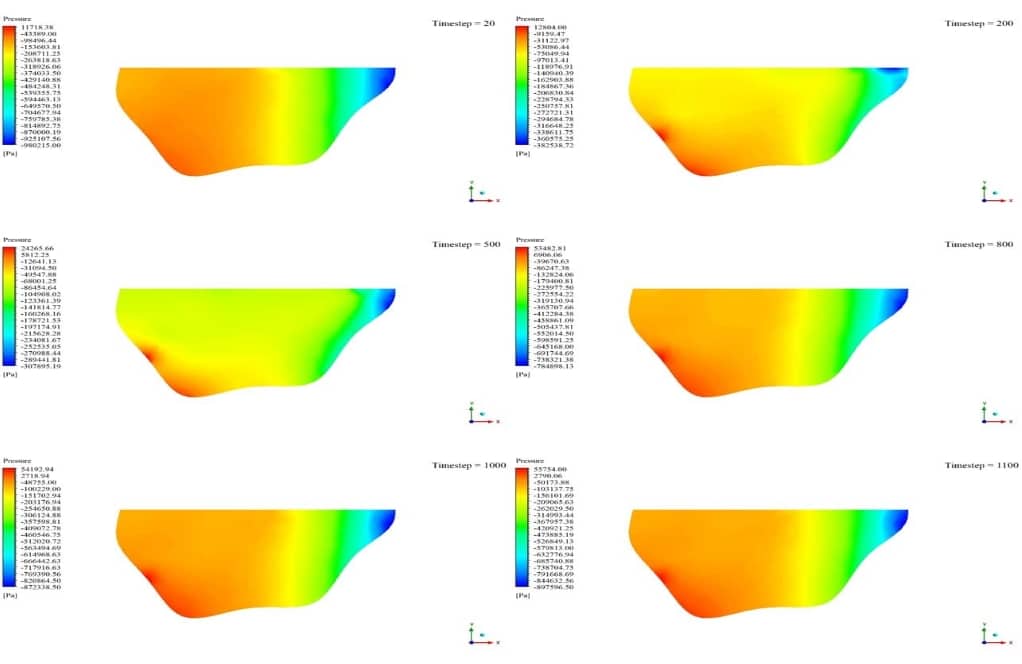
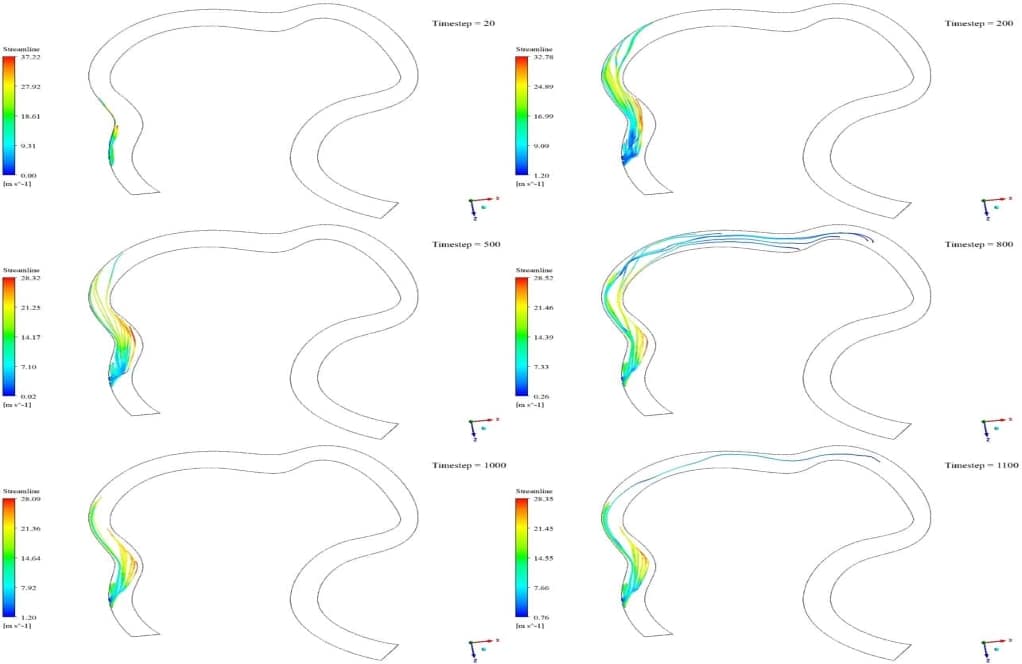
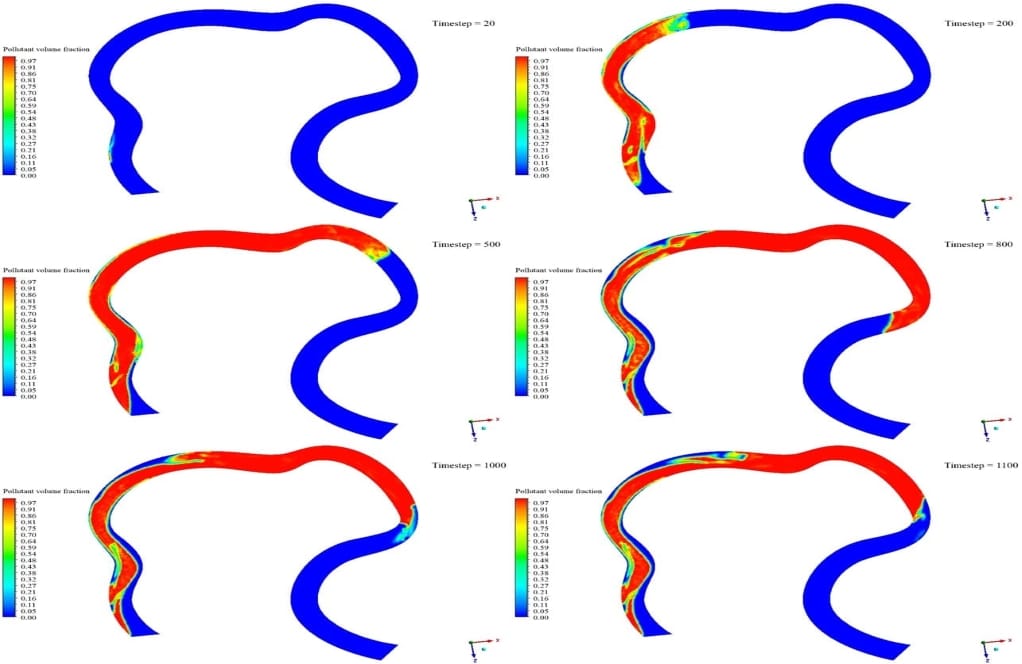
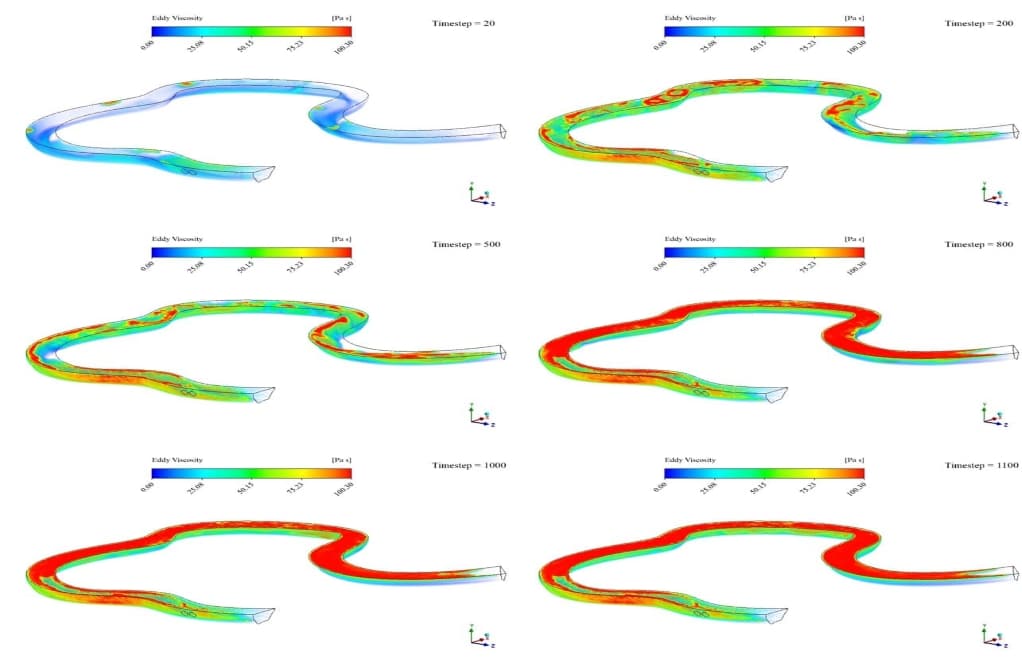
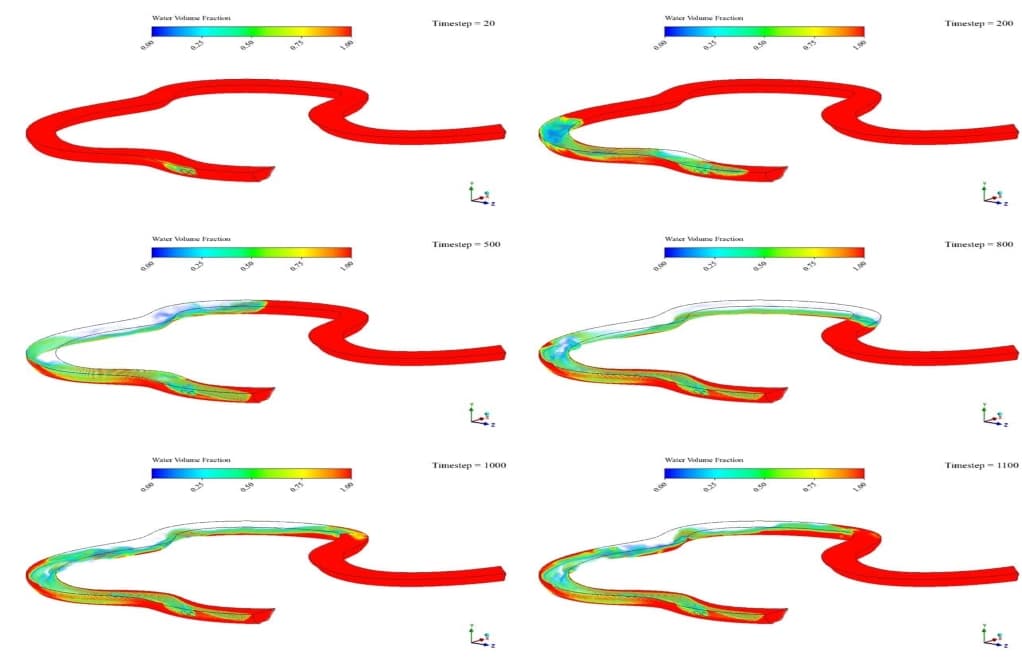



Christopher Dietrich –
The training provided clear steps in simulating water pollution in a meandering river using ANSYS Fluent. The use of transient analysis and the VOF model clearly displayed how pollutants spread across the river. The visuals support understanding pollutant distribution bullet-effectively. Impressed by the depth of analysis regarding water and pollutant volume fractions and how the meandering shape affects dispersion.
MR CFD Support –
Thank you for your positive review! We are thrilled to hear that you found the ANSYS Fluent CFD simulation training informative and effective in demonstrating the complexities of pollutant dispersion in a river. Your satisfaction with the visuals and depth of the analysis is greatly appreciated. We aim to deliver comprehensive and clear content to our users, and it’s rewarding to know that our efforts are resonating. If there’s anything else you’d like to explore or if you have further feedback, please feel free to get in touch!
Mrs. Tara O’Keefe –
I was impressed by the attention to real-world scenarios in the simulation of water pollution in a meandering river. Can you explain further how the transient solver contributed to the accuracy of the results in a dynamic environment like river pollution?
MR CFD Support –
The transient solver plays a critical role in capturing the time-dependent nature of water pollution in a river. It allows for the simulation of pollutant dispersal over time, reflecting the downstream movement of pollution due to the river’s flow as well as the mixing and diffusion processes. Since pollution events and concentrations fluctuate, using a transient solver provides a more realistic depiction of how pollutants behave and interact with the river’s ecosystem.
Madyson Hickle –
I’m thoroughly impressed with the level of detail in the Water Pollution in the Meandering River CFD simulation training. The inclusion of factors like pollutant diffusion and the effect on water flow is very instructive. Keep up the fantastic work at MR CFD in providing such comprehensive educational material!
MR CFD Support –
Thank you for taking the time to leave such a positive review! We are delighted to hear that our Water Pollution in the Meandering River simulation training met your expectations and provided you with valuable insights. MR CFD is committed to offering high-quality simulations that help our users understand complex mechanisms. Don’t hesitate to reach out if you need further assistance or more resources for your CFD learning journey!
Matilde Kreiger –
Your explanation on how water pollution spreads in the river’s surface was very detailed and helped me understand the impact. Great job on the visualization of the pollutants’ dispersion throughout the river!
MR CFD Support –
Thank you for your kind feedback! We are thrilled to know our detailed explanations and visualizations aided your understanding of water pollution dynamics. It’s our priority to provide clear and comprehensive training material. If you have any more questions or if there’s any other way we can assist your learning experience, please let us know!
Prof. Jerrell Hartmann DVM –
I was fascinated by how water pollution spreads in rivers. Can you tell me what impact the K-epsilon Realizable model has in this particular simulation?
MR CFD Support –
In the simulation of the meandering river’s pollution, the K-epsilon Realizable model helps in accurately predicting the turbulent flow of the river water. This, in turn, has a significant effect on the diffusion and transportation of pollutants within the river. The model accounts for the effects of the swirls and fluctuations in velocity, which are common in natural meandering rivers, allowing for a more detailed and realistic simulation of how the pollution disperses along the river’s path.
Leonora Sawayn –
The training was superbly detailed! Managed to simulate my own polluted river scenario by following along. Could you expand on how to analyze the eddy viscosity effects in such simulations?
MR CFD Support –
We’re thrilled to hear you had a great learning experience! When analyzing eddy viscosity in these types of simulations, you can monitor it in the results section. Look at the contour of eddy viscosity to observe areas of increased turbulence and relate this to how pollutants diffuse. Compare them with velocity fields to understand the interplay between flow patterns and mixing rates.
Leola Konopelski –
I’ve learned so much about simulating water pollution with your training material! It’s fascinating to see the pollutant diffusing in the river over time.
MR CFD Support –
Thank you for your kind words! We’re delighted to hear that our training material on water pollution in the meandering river simulation using ANSYS Fluent was informative and fascinating for you. It’s rewarding to know that our efforts to provide comprehensive CFD training have contributed to your learning experience. If you have any further questions or need additional assistance in future projects, please don’t hesitate to reach out.
Ezequiel Bins –
The tutorial mentions pollutant diffusion over time. Was a specific diffusion coefficient or model used to simulate the pollutants’ interaction with the water?
MR CFD Support –
In the simulation, the interaction of pollutants with the water is handled through the VOF model. Additionally, the diffusion of pollutants can be captured using the software’s inbuilt species transport models which calculates the diffusion coefficient based on the contaminants’ properties and the flow characteristics.
Prof. Sibyl Cartwright I –
The detailed explanation of the Water Pollution in the Meandering River simulation offered a comprehensive look into the methodology and results of the project. It thoroughly demonstrates the application of the VOF multi-phase model in tracking the dispersion of pollutants in river systems, showing very practical applications to real-world environmental studies. Such a high-fidelity simulation capability is valuable for planning pollution mitigation strategies. I was particularly impressed with the capacbilities also shown to model the complexities of turbulent flow and diffusion processes.
MR CFD Support –
Thank you for your generous feedback on our ‘Water Pollution in the Meandering River, Ansys Fluent CFD Simulation Training’ product. We’re delighted to hear that the project impressed you and that you found value in our comprehensive simulation approach for environmental studies. At MR CFD, we continuously strive for such realistic applications to aid in environmental management and research. Grateful for customers like you, we hope our products continue to serve your professional and educational needs well.
Crystel Ruecker –
Wonderfully detailed! It seems that the pollutant enters at 5m/s, which appears much slower compared to the river’s 35m/s inlet flow. Did this difference in flow velocity impact the rate of pollution dispersion along the river? And if so, how was this effect of differing velocities demonstrated in the simulation results?
MR CFD Support –
In our simulation, we accounted for the difference in flow velocities. Since the pollutant enters the water with a lower speed, it initially has less momentum compared to the river water. However, the dispersion and spread of pollution are not solely reliant on the inlet velocity of the pollutant; river flow, turbulence, and diffusion play significant roles. The slower movement of the pollutant compared to the river’s flow allows for observable diffusion and mixing over time, which is fully captured in our CFD results. Through streamline and volume fraction contours, the simulation represents the dilution and downstream transport of the pollutant. Also, fluid dynamics principles such as advection and diffusion are considered to accurately showcase the pollution pattern within the river in our transient analysis.
Paul Hermann PhD –
I’m really interested to know how the river bend geometry affects the diffusion of pollution. Can you elaborate on that based on the simulations?
MR CFD Support –
The geometry of the river bends has a significant impact on the diffusion of pollution. In a meandering river, the flow velocity is not uniform; it’s faster on the outside of the bend and slower on the inside. As a result, pollutants may disperse unevenly and can accumulate on certain parts of the riverbed where flow is slower. The confluence of varying velocities also leads to complex turbulence patterns that can further affect the spread of pollutants. The simulation in this training specifically looks into these aspects, replicating how pollution behaves in such scenarios, and offers insights into the pathways and concentration levels at various points along the river.
Brook Moen –
The detailed simulation captures the dispersion of pollutants in a meandering river very well. It’s interesting to see the use of VOF and the effect of river surface contamination visualized over time. Great work!
MR CFD Support –
Thank you for your positive feedback! We are glad to hear you found the CFD simulation informative and helpful in understanding water pollution dynamics in a meandering river. If you have any further questions or curiosities about the simulation, feel free to reach out.